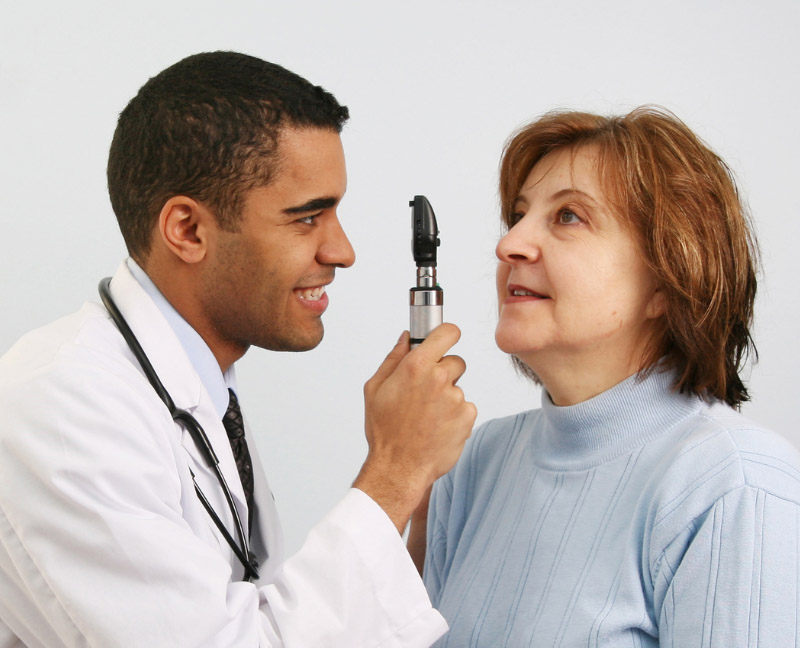What Your Eyes and Ears Can Tell Your Doctor

Have you ever wondered exactly what your doctor is looking for when they start peering into your eyes and ears? It’s a routine that often happens at well visits, and according to Dr. Ahmed Nashat, Shore Physicians Group primary care physician at their Somers Point office, it’s one that can tell your doctor quite a bit about your health. The primary tools your doctor uses are the ophthalmoscope to see into the eyes, and the otoscope to see into your ears. These instruments serve as gateways to early detection, accurate diagnosis, and improved patient outcomes.
What your doctor can learn from your eyes
In order to see into the interior structures of your eye, your doctor uses an ophthalmoscope, a hand-held tool with a light and various lenses. The ophthalmoscope helps detect and manage a variety of ocular conditions and systemic diseases.
- Detecting eye conditions: Ophthalmoscopy enables your primary care doctor to visualize the retina, optic nerve, and blood vessels within the eye. This is essential for identifying and monitoring ocular pathologies such as diabetic retinopathy, glaucoma, and age-related macular degeneration. Early detection of these conditions allows for timely intervention and management, preventing further vision loss and improving overall patient well-being.
- Systemic Disease Screening: The eyes serve as windows to your overall health, and ophthalmoscopy can provide valuable insights into various systemic diseases such as hypertension, diabetes, and cardiovascular diseases. These conditions often manifest with observable changes in the eye’s blood vessels. Primary care physicians, armed with an ophthalmoscope, can detect these signs early on, facilitating early intervention and holistic patient care.
- Neurological Assessment: The optic nerve, an extension of the central nervous system, is directly observable through ophthalmoscopy. Changes in the optic nerve head can be indicative of neurological conditions such as increased intracranial pressure or optic neuritis. Primary care providers can use ophthalmoscopy as a non-invasive tool to aid in the assessment of neurological health, prompting further investigations and specialist referrals if necessary.
Why your doctor peers into your ears
Otoscopy, the visual examination of the ear using an otoscope, is a vital component of primary care practice. This diagnostic tool allows primary care physicians to assess the external auditory canal and tympanic membrane, facilitating the detection, diagnosis, and management of various ear conditions.
- Detection of Ear Infections: Otoscopy is instrumental in identifying common ear conditions, particularly infections of the external and middle ear. Through visual examination, primary care providers and ear and nose specialists can observe signs of inflammation, redness, or the presence of discharge, aiding in the accurate diagnosis of conditions such as otitis externa (inflammation of the ear canal, also known as swimmer’s ear) and otitis media (middle-ear infection). Early detection enables timely intervention, reducing the risk of complications and improving patient outcomes.
- Assessment of Tympanic Membrane: The otoscope allows for a detailed examination of the tympanic membrane, providing valuable information about the health of the middle ear. Primary care physicians can identify perforations, signs of retraction, or the presence of fluid behind the membrane—all crucial indicators of conditions like middle ear infections or Eustachian tube dysfunction. This visual assessment guides appropriate treatment strategies and referral decisions.
- Foreign Body Detection and Removal: Otoscopy is an essential tool for identifying foreign bodies in the ear canal. Children, in particular, are prone to inserting objects into their ears, leading to discomfort and potential complications. Primary care providers can use otoscopy to visualize and safely remove foreign bodies, preventing further injury and ensuring the well-being of the patient.
In conclusion, ophthalmoscopes and otoscopes reveal more than meets the initial gaze. They serve as portals into the eyes and ears to help your doctor with early detection, accurate diagnosis, and timely intervention. So, the next time your doctor conducts your eye and ear exams, you’ll better understand the depth of insight gained – for in these routine examinations lies a profound commitment to your well-being and a proactive approach to maintaining your health.
Dr. Ahmed Nashat practices primary care at Shore Physicians Group’s Somers Point office, located at 401 Bethel Road. To schedule an appointment, call 609-365-6200.